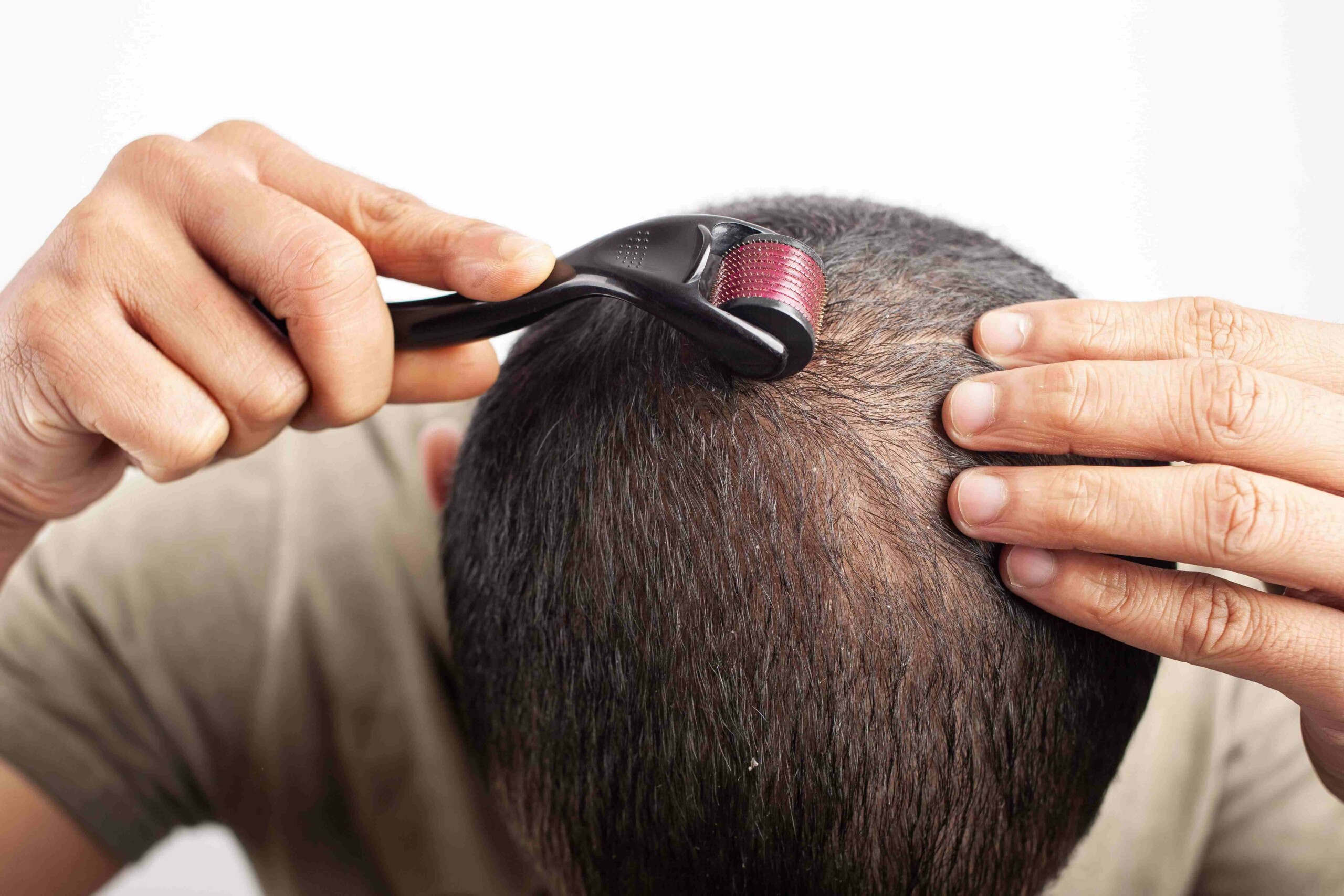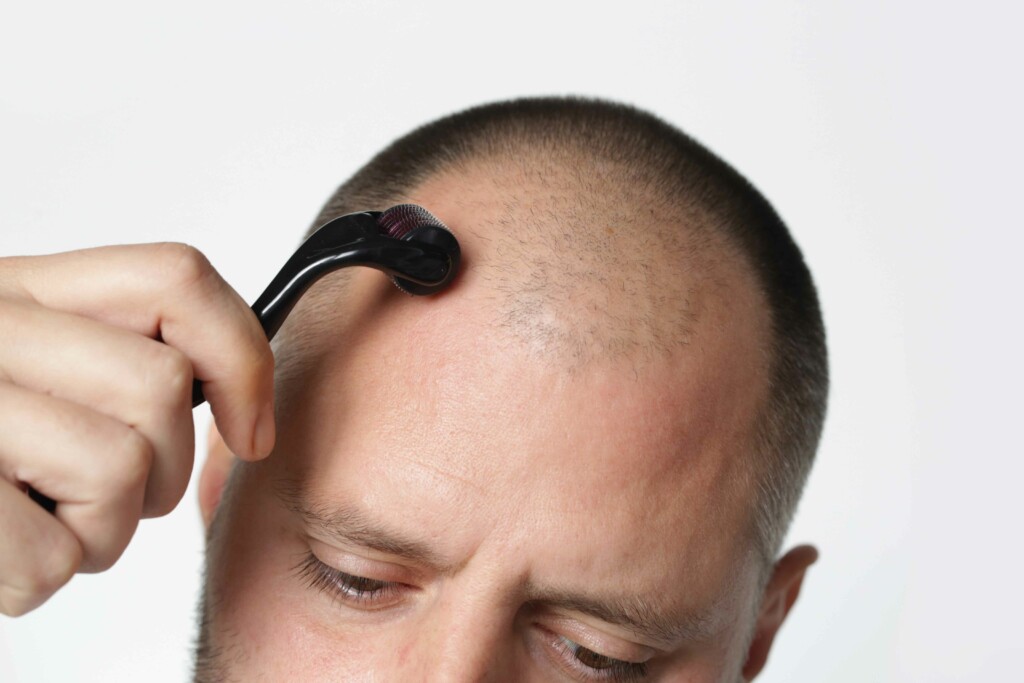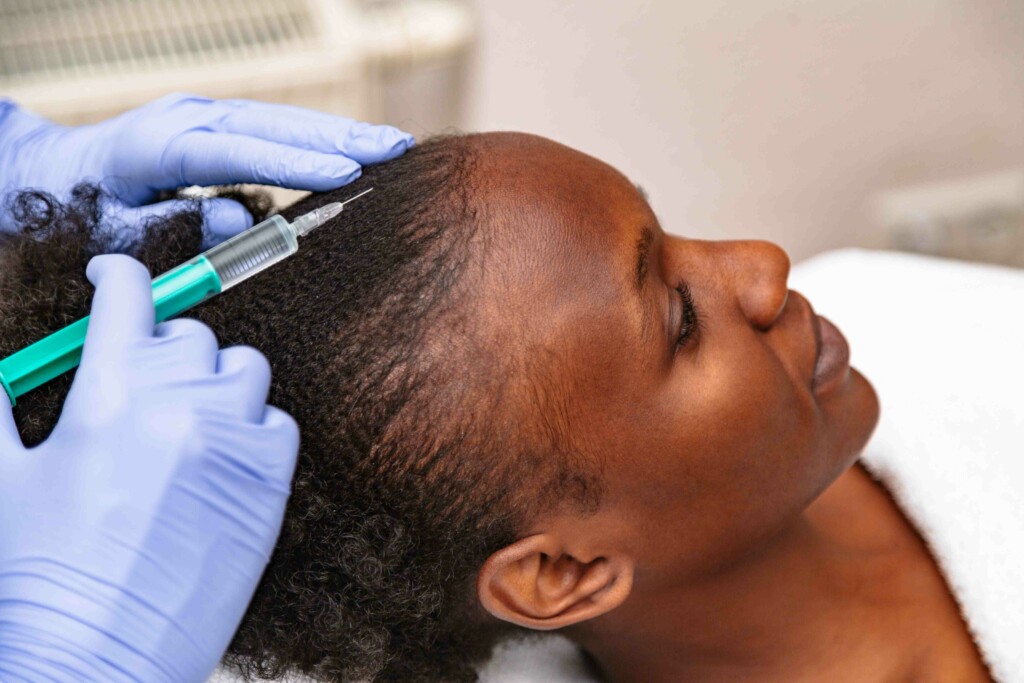Microneedling is a procedure that was developed in the mid-1990s. Microneedling treatments were first performed to help reduce scars, and were later modified so they could be used for a variety of other purposes, including collagen induction therapy, skin rejuvenation, and most recently, hair regrowth.
As these treatments became more popular, specific devices were developed for different microneedling procedures. These days, dermarollers are one of the most popular microneedling devices available.
Microneedling vs. Dermarolling
Dermarolling refers to a type of microneedling device. Dermarollers are handheld, affordable, easy to use, and come in a range of sizes. Both manual and automated dermarollers are available.
A standard dermarolling device is usually 2-x-2 centimeters wide. Each of these cylindrical devices has 192 microneedles. These microneedles are typically arranged in rows of 8-by-24 along the surface of the cylinder. (1)
Passing one of these standard microneedling devices along your skin creates 16 micro-punctures each time. If you were to roll one of these devices along your skin 15 times, you would end up with about 250 tiny holes per cm2 of skin.
Dermaroller vs. Dermapen vs. Other Devices
In addition to dermarollers, there are several other types of microneedling tools, like derma stamps. These are essentially fixed, non-rolling, miniaturized versions of the dermaroller for localized areas. There’s also the Dermapen, which is an automated derma stamp-type device that’s made in the shape of a large pen. (1)
In addition to the main dermaroller and dermapen types of devices, a variety of novel microneedling tools have also been created. These include LED-dermarollers, radiofrequency microneedling devices, and the DermaFrac, which combines microdermabrasion, LED therapy, and microneedling. (1) All of these devices are used for dermatological purposes, but not all of them are used to treat hair loss.
The Mechanics of Dermarolling for Hair Loss
Dermarolling uses a handheld, cylindrical device to create micro-punctures in your skin. These are considered to be microtraumas, because the holes are very small and only affect the superficial layers of the skin.
Dermarolling devices with short needles, like those for home use, only penetrate the skin’s top layer, known as the epidermis. The longer needles of medical-grade dermarolling devices allow these devices to penetrate the second layer of skin, called the dermis, where hair follicles reside.
The ability to penetrate the dermis and not just the epidermis is a pretty big deal when it comes to hair regrowth. When the skin’s dermis experiences microtraumas, a variety of different growth factors and proteins are released. Some of these are related to hair growth. (4)
Microneedles start to penetrate the dermis when they are at least 1 millimeter (1,000 μm) long. However, microneedle lengths of 1.5 millimeters (1,500 μm) can accomplish this more accurately and effectively. (2)
However, dermarolling devices with longer needles aren’t usually sold to the public. This is the main reason it may be best to seek out a clinic that offers dermarolling treatments. Hair loss clinics can also help boost the effectiveness of your treatment by combining dermarolling with other custom hair loss treatments, like platelet-rich plasma therapy or topical dutasteride.
Dermaroller Types and Their Uses
Dermarolling is a type of microneedling that uses a handheld, cylindrical device to create micropunctures in your skin. There are five main types of dermarolling devices registered with the FDA. These range from cosmetic dermarollers that are sold online and over the counter to medical-grade devices that are meant to be used by aestheticians and medical professionals. (1)
Cosmetic Dermarolling Devices (C-8)
Type C-8 devices have 192 tiny needles that are only 0.13 millimeters (130 μm) long. These needles are so small that they are considered painless. These cosmetic dermarolling devices are generally used to enhance the penetration of topical serums or creams.
Cosmetic Dermarolling Devices for Areas of Skin With Hair (C-8HE)
Type C-8HE devices have slightly longer needles that are 0.2 millimeters (200 μm) long. Microneedles of this length are also too small to trigger much of a pain response. These cosmetic dermarolling devices are meant to be used on the scalp and other areas with dense hair growth. Like type C-8, type C-8HE devices also have 192 microneedles.
Medical-Grade Dermarolling Devices for Collagen Induction (CIT-8)
Type CIT-8 devices have 192 microneedles that are 0.5 millimeters (500 μm) long. These devices trigger collagen induction and can promote skin remodeling.
Medical-Grade Dermarolling Devices for Scar Reduction (MF-8)
Type MF-8 devices have 192 microneedles that are 1.5 millimeters (1,500 μm) long. These longer microneedles are used to create deeper microchannels throughout the skin’s epidermis and dermis. They can destroy bundles of collagen-forming scar tissue to help reduce scarring.
Medical-Grade Dermarolling Devices for Facial Scar Reduction (MS-4)
Type MS-4 devices also tend to have needles that are 1.5 mm (1,500 μm) long. However, this dermaroller is smaller in size compared to other devices, with a total of 96 needles.
Type MS-4 devices are primarily used for facial acne scars where precise, deeper penetration is needed. If the targeted area is around the eyes or mouth, where facial skin is thinner, the device will have smaller needles that are 0.5-0.75 millimeters (500 to 750 μm) long.
Choosing the Best Dermaroller for Hair Loss
If you’re intending to use a dermaroller at home, you’re probably going to be restricted to purchasing cosmetic dermarollers with microneedle sizes on the smaller end of the scale. These devices generally have 192 microneedles that are around 0.13 to 0.2 millimeters (130-200 μm) in length.
But before you jump to buy a type C-8 or type C-8HE dermaroller for hair growth, you should know that not all dermarollers are created equal. For instance, some microneedling devices for home use were designed to cover larger surface areas, like the stomach or thighs. These devices will be much larger, with as many as 480 needles distributed across three separate cylindrical drums. And obviously, you shouldn’t try to use such a large dermarolling device on your head.
Instead, you might want to consider getting microneedling treatments in a clinic that uses medical-grade dermarollers. The medical-grade dermarollers used in clinics generally have longer needles than the ones sold for home use. Treatments in clinics may also be combined with delivery of serums with growth factors, or medications, or with pre-care or post-care treatments, which can help boost new hair growth. These additional treatments can make a big difference.
Why bother with a clinic that uses medical-grade dermarollers, you might ask? Although the dermarollers designed for home use are affordable, there are few scientific reports studying efficacy for hair regrowth. Rather than using cosmetic dermarollers for the scalp with small, 200 micrometer (μm) needles, medical-grade dermarolling devices are assessed, instead.
In fact, some studies use dermarollers that don’t even fit into the main five FDA categories listed above. For instance, one study reported dermarollers with needles as long as 3 millimeters (3,000 μm) being used for skin rejuvenation. (2) Publications have also reported different needle lengths when using dermarollers for hair regrowth, ranging from as small as 0.5 millimeters (500 μm) to as much as 1.5 millimeters (1,500 μm). (3,4)
Microneedling Can Help Treat Androgenetic Alopecia
Compared to FDA-approved hair loss treatments like minoxidil and finasteride, microneedling is fairly new. However, there has been an explosion of microneedling studies in the last few years. Time and time again, these studies have shown that microneedling can help support hair loss treatments and improve hair regrowth. There’s just one catch: most of these studies show that microneedling works well in combination with another hair loss treatment. (3,6,7)
Using a Dermaroller and Minoxidil
Topical minoxidil is a well-known, effective, FDA-approved treatment for male and female pattern hair loss. This topical hair loss treatment is sold over the counter in concentrations of 2 and 5 percent in both liquid serum and foam formulations. While the 5 percent version is thought to be the most effective, even this type of minoxidil doesn’t work for everyone. (5)
A study of 100 men explored the effectiveness of using 5 percent minoxidil twice a day, compared to the weekly use of dermaroller with minoxidil 5 percent (applied twice a day). The dermaroller’s needles were 1.5 millimeters (1,500 μm) long. (6)
After 12 weeks of treatment, the hair count of the men using minoxidil 5 percent was 22.2 cm2. In comparison, the hair count of the men who had used minoxidil and a dermaroller was 91.4 cm2. Similarly, the vast majority (82 percent) of people who received the dermaroller-minoxidil treatment reported an improvement of more than 50 percent in their hair growth. And in contrast, only 5 percent of the people using minoxidil reported similar results. (6)
Using a Dermaroller, Minoxidil, and Finasteride
Microneedling has also been studied in conjunction with both topical minoxidil and oral finasteride. A report of five patients demonstrated moderate to great hair regrowth when weekly dermarolling was added to their usual treatments of topical minoxidil and/or oral finasteride over a 3-month period. (7)
Notably, these men had not been responding well to treatment with FDA-approved medications. Three of them had already been combining daily finasteride with 5 percent minoxidil without much improvement. All but one of the five men were happy to combine dermarolling, minoxidil, and finasteride (who opted for just dermarolling with minoxidil). This study also performed weekly microneedling treatments and used a dermaroller with needles that were 1.5 millimeters (1,500 μm) long. (7)
After 3 months of treatments, four of the five men reported an improvement of more than 75% in their hair growth. The only person who did not improve was the individual who had refused to take finasteride. However, a year and a half later, his hair loss had not progressed further, either. (7)
Combining Microneedling With PRP
When people are not responsive to FDA-approved hair loss treatments like minoxidil and finasteride, they sometimes seek out alternative hair loss treatments, like platelet-rich plasma (PRP) therapy. This hair loss treatment takes a preparation of your own platelets concentrated in plasma, then injects them into the scalp. Like microneedling, PRP is meant to help counteract hair loss by increasing the growth factors in the treated areas of the scalp.
One study explored the effects of twice-daily 5 percent minoxidil compared to twice-daily 5 percent minoxidil combined with PRP-microneedling treatments once a month. After 6 months (equivalent to six PRP-microneedling treatments), 92 percent of the patients receiving minoxidil, PRP, and microneedling treatments had moderate to excellent improvement in their hair growth. Comparatively, only 48 percent of minoxidil users showed the same moderate to excellent improvement. (4)
Improvements in hair regrowth have also been seen when using microneedling and PRP without an FDA-approved hair loss treatment. Another study explored this combination treatment in men and women who were unresponsive to minoxidil and finasteride. They found that just four PRP-microneedling treatments (administered once a month) were sufficient to achieve very good improvements in hair regrowth for 66 percent of individuals. (8)
The men and women who were slower to respond were given an additional one or two treatments. While combining PRP with microneedling did not work for everyone, over 81 percent of the total people studied were satisfied with the results of this hair loss treatment. (8)
How Many Dermaroller Hair Growth Treatments Do You Need?
There’s no set protocol for using dermarollers to support hair regrowth. Some studies administer microneedling treatments with dermarollers once a month for a few months, while others offer weekly treatments. However, you’ll likely need at least four sessions and you may need as many as 12. (4,6-8)
Once your initial treatments are complete, it’s not clear how often maintenance treatments are required. Few studies have explored long-term use of microneedling devices. However, one patient in a study chose to continue intermittent microneedling treatments every 2-3 weeks for 18 months in conjunction with both minoxidil and finasteride. His hair regrowth was maintained over this period without any complications. (7)
Using a dermaroller for hair loss can be a great choice, especially for people who are unresponsive to topical minoxidil or oral finasteride. However, this treatment is likely to work best when using a medical-grade microneedling device – which usually means going into a clinic for treatments – and combining it with a topical treatment like minoxidil. A hair loss clinic can also advise you on the number of sessions needed and alternative hair loss treatments you can try using at the same time.
References
- Singh, A., & Yadav, S. (2016). Microneedling: Advances and widening horizons. Indian dermatology online journal, 7(4), 244.
- Dsouza, L., Ghate, V. M., & Lewis, S. A. (2020). Derma rollers in therapy: the transition from cosmetics to transdermal drug delivery. Biomedical Microdevices, 22(4), 1-11.
- Chandrashekar, B. S., Sandeep, M. A., Vani Vasanth, J. P., & Rajashekar, M. L. (2015). Triamcinolone acetonide mesotherapy in the treatment of recalcitrant patches of alopecia areata—a pilot study. J Clin Dermatol Ther, 2(1), 1-4.
- Shah, K. B., Shah, A. N., Solanki, R. B., & Raval, R. C. (2017). A comparative study of microneedling with platelet-rich plasma plus topical minoxidil (5%) and topical minoxidil (5%) alone in androgenetic alopecia. International journal of trichology, 9(1), 14.
- Badri, T., Nessel, T. A., & Kumar, D. (2021). Minoxidil. In StatPearls [Internet]. StatPearls Publishing.
- Dhurat, R., Sukesh, M. S., Avhad, G., Dandale, A., Pal, A., & Pund, P. (2013). A randomized evaluator blinded study of effect of microneedling in androgenetic alopecia: a pilot study. International journal of trichology, 5(1), 6.
- Parajuli, S., & Paudel, U. (2020). Microneedling for androgenetic alopecia not responding to conventional treatment. Our Dermatol Online, 11(2), 140-142.
- Yepuri, V., & Venkataram, M. (2021). Platelet-rich plasma with microneedling in androgenetic alopecia: Study of efficacy of the treatment and the number of sessions required. Journal of cutaneous and aesthetic surgery, 14(2), 184.
Last updated April 2023




